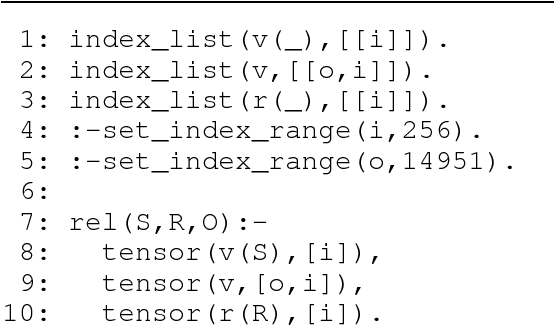A tensorized logic programming language for large-scale data
Paper and Code
Jan 20, 2019


We introduce a new logic programming language T-PRISM based on tensor embeddings. Our embedding scheme is a modification of the distribution semantics in PRISM, one of the state-of-the-art probabilistic logic programming languages, by replacing distribution functions with multidimensional arrays, i.e., tensors. T-PRISM consists of two parts: logic programming part and numerical computation part. The former provides flexible and interpretable modeling at the level of first order logic, and the latter part provides scalable computation utilizing parallelization and hardware acceleration with GPUs. Combing these two parts provides a remarkably wide range of high-level declarative modeling from symbolic reasoning to deep learning. To embody this programming language, we also introduce a new semantics, termed tensorized semantics, which combines the traditional least model semantics in logic programming with the embeddings of tensors. In T-PRISM, we first derive a set of equations related to tensors from a given program using logical inference, i.e., Prolog execution in a symbolic space and then solve the derived equations in a continuous space by TensorFlow. Using our preliminary implementation of T-PRISM, we have successfully dealt with a wide range of modeling. We have succeeded in dealing with real large-scale data in the declarative modeling. This paper presents a DistMult model for knowledge graphs using the FB15k and WN18 datasets.
 Add to Chrome
Add to Chrome Add to Firefox
Add to Firefox Add to Edge
Add to Edge